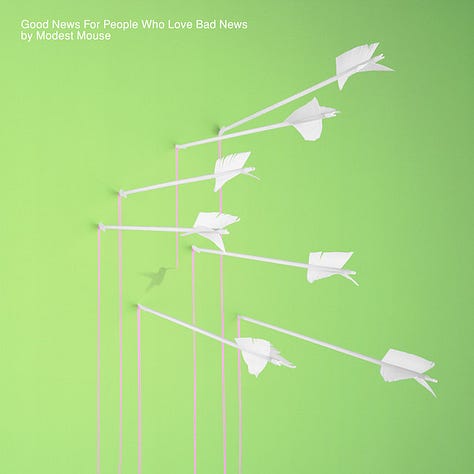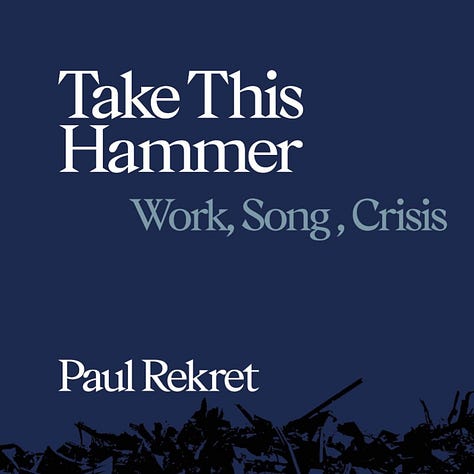Welcome to the February 2025 edition of Worms of the Senses, a (sort of) monthly feature where I comb through the best things I heard, saw, read, and pondered in search of something like a structure of feeling. It probably comes as no surprise that February 2025 felt pointedly cruel and aggressively absurd. Not strange, not weird, not odd, and certainly (mostly) not funny. Absurd. In the existential-adjacent, Endgame and Rhinoceros kind of way. Welcome to hell. Sorry we started without you. Also…
Squid’s third album Cowards was released on February 7th. It is the group’s tightest and most cohesive, reining the post-punk avant-gardism into something still very manic and experimental. That they’ve found such a strong and distinctive direction over the course of just four years (their debut full-length Bright Green Field was released in mid 2021) is impressive. What remains intact is a kind of sensory overload, an uneasy feeling like we’re experiencing too much at once. As if every attempt at grounding ourselves is bound to become just another jagged piece of mental flotsam inundating us. Despite the chaos of Cowards being more controlled, its subject matter – examinations of evil’s banality – are probably the darkest the band has taken up.
A few examples: “Blood on the Boulders” is about the Manson murders. “Building 650” is about a serial killer friend – Frank, “a true American” – that the narrator can’t bring himself to escape, raising the question of his own complicity. Opening track “Crispy Skin” reverses this viewpoint. The narrator is a cannibal. “What’s wrong with me?” he asks, but he also implies that the world around him has let him get away with it, even accepting and encouraging his gruesome diet. (Takashi Ito’s video for the song provides an alluring interpretation for this.)
Even with the music of Cowards so compelling, it rather defies you to glean greater meaning from it. I have found a helpful, though unexpected, affinity between Cowards and Modest Mouse’s seminal 2004 album Good News for People Who Love Bad News. Both exhibit an unhinged confusion, a profound anxiety of realizing all your efforts inconsequential in an indifferent world. (As they say in “Bury Me With It,” “Life handed us a paycheck, we said ‘we worked harder than this!’”)
The difference is that twenty years ago we could laugh at this state of affairs, this universe that often seems deliberately constructed to lack sense. Not so much now, save the occasional acerbic chuckle. What’s notable here, though, is that in most instances, it’s not the violent actors themselves who are called out on Cowards, but the world that invents this violence.
What lies at the core of a world capable of this? It would be wrong (and boring) to answer this question with some kind of Marxist schematic, insisting it’s all about work. Exploitation? Feasibly. Certainly an extreme-but-ordinary form of alienation. But as Paul Rekret argues in his recent book Take This Hammer, most music is in some way mediating our relationship to work, along with the anxieties and excesses that spring from attempts to reassert some kind of control.1



The book is part of Goldsmiths Press’ Sonics Series, radical dissections of music and being that fill a very real need in today’s musical-critical landscape. Rekret’s argument doesn’t rely so much on narrowing the scope of popular music as showing us how the logic of work and exploitation stitch together our daily existence. What music tells us about this when we are conscious of it can be quite insightful, revelatory even.
One of the book’s most compelling sections is on trap music – Migos, Gucci Mane, 2 Chainz – and resituating its all-encompassing illicit hustles as forms of labor, survival. The chapter on ambient music, which has become more dominant in the streaming age, also asks us to look at the genre differently, from a style that ostensibly aims to create soothing spaces to one that contents us with our own overwhelm. Even when we are at rest, we are at work. The rhythms of our own needs and desires and those of the outside world are inevitably at odds.
Everyone understands this. If not on a theoretical level then certainly on a visceral emotional one. Which is one of the reasons that a show like Severance has gained the critical praise it has. The premise of a consciousness bifurcated, your work self versus your leisure self, unable to remember and often at war with each other, basically works. It’s not at all difficult to map a crude understanding of alienation onto this, and it’s clearly why a small but dedicated number of viewers resonate with the show. I’d be interested to see a breakdown of how many of the show’s fans have worked for any length of time in white collar office environments.
I’ve seen Severance described as Twin Peaks meets Office Space, and that shoe fits, even if the writers make it a point to do something very particular with the formula. Much of it feels like the direction Michel Gondry’s work might have taken had his oeuvre not become so banal. The wintry gray northeastern setting, the understated acting choices, the modern-anachronistic technologies; all come together to create a setting where the utterly mundane produces the excessively weird. Some viewers seem to find the whole aesthetic anodyne and vague, difficult to get drawn into, but that’s the point. You’re supposed to be estranged.2
The problem is that, even with this premise so fleshed out, it isn’t immediately apparent where it can go without completely upending the logic of that world. I was skeptical they’d be able to do much past the first season, but the second season is being smart about it. Further exploring the structures and histories of Lumon – the company that “severs” its employees – in essence reveals it to be a cult of sorts, complete with its own strange mythos and origin stories that justify its quotidian cruelties. Again, it may be a bit obvious, but it’s dramatized in a compelling way.
Now switch streams. All culture is either alienating or expresses alienation, articulating forces that are somehow fully human and yet appear well beyond our control. And if it is beyond our control, if there is no route of exit, then what’s the point of exploring it through the arts? That, essentially, is the a priori question that every absurdist work has to answer. Most absurdist art simply finds a more specific way to pose the question. Necessary, but not exactly an answer. Which way to get out?
The films of Sara Gomez, which I’ve been binging on the Criterion Channel, provide one of the closest things to a plausible answer I’ve found in some time. Gomez was a Cuban filmmaker. She died in 1974 at the age of 31. Her films explored problems of daily life in the era after the revolution. Most are under an hour in length, and many are less than twenty minutes. I’m sure people would disagree about whether we could call them straightforwardly absurdist but they do take on everyday, almost mundane problems, in puckish ways.
Un documental a propósito del tránsito, or A Documentary About Traffic, documents traffic accidents in Cuba and the efforts of local revolutionary governments to better educate residents on safe driving practices and to better redesign city streets. It interviews drivers, urban planners, government officials. Reading this, you would think it watches more like an industrial informational video, but the action is interspersed with title cards whose almost cartoonish playfulness contrasts with the dry statistics of accidents and injuries. It is, essentially, an attempt at popular education that uses its filmic qualities in an extremely self-aware way. Two of her final films, Atención prenatal (Prenatal Attention) and Año uno; Mi aporte (First Year) bring the same sensibility to the massive changes in prenatal and postnatal care in Cuba as its free healthcare system was established. Given the dismal state of healthcare before the revolution, these short docs served to popularize the idea that working women deserved and should expect better.
Poder local, poder popular, or Local Power, Popular Power, examines the neighborhood-based revolutionary councils of Cuba through the eyes of a small sugar mill town as it confronts shortages of goods. Local workers and party activists are interviewed, keywords and phrases emphasized by way of (once again) bold title cards. It is a short and open-ended film, without much in the way of resolution, but it shows new and different experiments in how to organize daily life. If existence is meaningless, create meaning. How does one find meaning when circumstances are beyond your control? You reach for them as if they are in your grasp. There’s a good chance that the only way to do so effectively is collectively. There’s no guarantee you’ll be able to create that meaning. Then again, it’s not like you have any choice but to try.
Header image is a still from Takashi Ito’s video for Squid’s “Crispy Skin.”
A more in-depth review of Take This Hammer is forthcoming, likely for the Historical Materialism website.
At this point the verfremdungseffekt of Brecht’s plays – alienating the audience to some degree so they can look critically at the work – is actually so commonplace in late capitalism that writers often don’t even realize they’re employing it. Of course, those who are aware of it do it better, but sometimes it works even on accident. As to whether the writers of Severance know what they’re doing, the jury is still out, but signs are promising.







